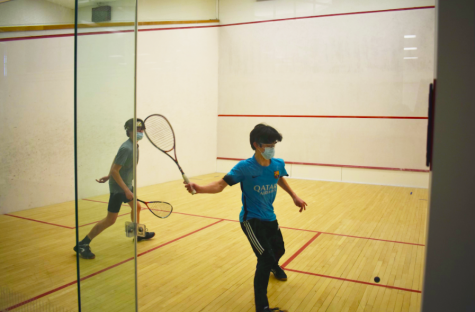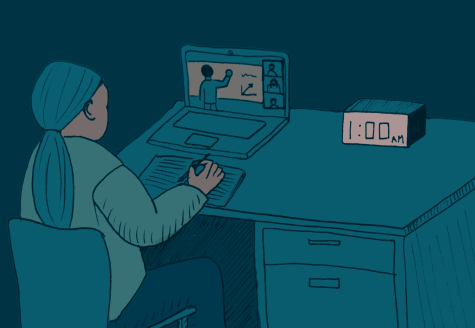Synchronous Classes: When Less is More
When Mr. Anderson dedicated his chapel talk to the interesting history of time zones across the world, nobody seated in the chapel that morning could have predicted that those very time zones would come to dictate our spring term schooling. As students left Groton and scattered across the globe, Groton found itself in a new predicament. How could the school continue to fulfill its goals of inclusive and equitable education even as all students now found themselves in a new home and often a new time zone?
Its 380 students now reside in 12 time zones that span 17 hours of the day, ranging from Alaska Daylight Time to Japan Standard Time. Groton, though, never seriously considered asynchronous classes. Instead the small group responsible for the transition to virtual classes focused energy on devising a schedule which would allow all students to appear in the same Zoom room at the same time. Headmaster Temba Maqubela had one refrain: “Less is more.”
With this guiding principal, Groton School settled on an abbreviated but synchronous schedule. Students would meet between the hours of 9:00am to 11:05 Eastern Daylight Time – that is 5:00am-7:05am Alaska Daylight time and 10:00pm-12:05am Japan Standard Time. While Academic Dean Kathy Leggat acknowledges this schedule is not equally easy for everyone, she also knows the importance of scheduling “classes when all could ‘attend’ so no one would need to rely solely on recorded classes.” Responses from Department Heads echoed these sentiments. Even though every teacher lost significant time, they saw the trade-off as worth it for the little face to face time it guaranteed.
Going from up to 240 class minutes per week down to 75 minutes requires significant adaptation. Early approaches, such as two, 55 minute classes 7 days a week or allowing and expecting the same amount of homework minutes per week, were soon discarded. As Ms. Leggat put it, expecting a fourth former, for example, to do the standard five hours of work per course, “while at home (or unable to be at home) with the worries of the current situation, of a parent suddenly unemployed or working in health care, of an ill or deceased family member, of younger siblings to care for, of chores to be done, of limited internet access,” or of anything else, was unrealistic.
Students, when surveyed, agreed. 97.4% preferred the current 5-day schedule to the alternative 7-day schedule. Additionally, a majority of students in other time zones reported a positive experience compared to standard classes. The biggest complaint in the early days of online classes was the volume of work, which has improved over the course of the term. Thus, in planning and in practice, less has proved more.
For now, it seems teachers are rising to the challenge. History Department Head Jennifer Wallace instructed her team to “begin with the end in mind,” then determine how to accomplish the most essential components of the course. For many, this means removing portions of the standard of curriculum to slim down the material, she added
Other creative solutions are emerging. Science Teacher Paula Marks, for example, rewrote her entire spring elective to change from her dissection-based Comparative Vertebrate Anatomy to a more Zoom-enabled Anatomy of Disease. Physics teachers Bert Hall and Dave Prockop substituted the normal lab activities for video demonstrations, interactive online labs, and experiments that could be conducted only with what students had in their home. Other classes translate well to home learning, such as the Ethics’ podcast project, whose interviews can be easily conducted and recorded via Zoom.
There are no illusions about what has been lost. Teachers, in a survey to all faculty that was answered by 14 people, frequently emphasized the loss of one-on-one time with students and the difficulty in determining how a class is going amidst the swarm of small Zoom boxes. Other teachers regretted how hard it was to know what a student may be dealing with while at home. Lastly, students and teachers alike reported the newfound screen fatigue uniquely tiring. All long for the days when we can return to the Schoolhouse.
However, teachers are still pleasantly surprised students showed up on time and engaged in active discussion, and consistently thankful for Groton’s small size and ability to accommodate these changes.
Given all these concerns — the disparate time zones, varying home situations, and general loss of community — the school instituted many measures to support students. First and foremost, the school was willing to purchase Wi-Fi for students who did not have it. According to Ms. Leggat, attendance is taken in every class but no punishments are issued. Instead it’s used to track students missing from multiple classes so advisors can check in if needed. Departments meet weekly to compare notes and best practices. Advisors, dorm heads, teachers, and clubs are all instructed to meet as frequently as makes sense. Teachers must be consistently available for out-of-class meetings. Finally, there is a team of people from the dean’s office, counseling center, health center, academic office, and a few others who meet twice as often as normal. They combine any known information about kids who are struggling and determine a plan of support.
As attention turns to the looming question of fall classes, the attitudes forged this spring – of less is more and of prioritizing connection – will continue to guide the decision-making process of the school. As always, one of the most important aspects of the synchronous learning plan is flexibility. No decision is final and feedback is gathered as frequently as possible. As Ms. Wallace phrased it, “teachers want to know what works, and we want to know it yesterday!”











